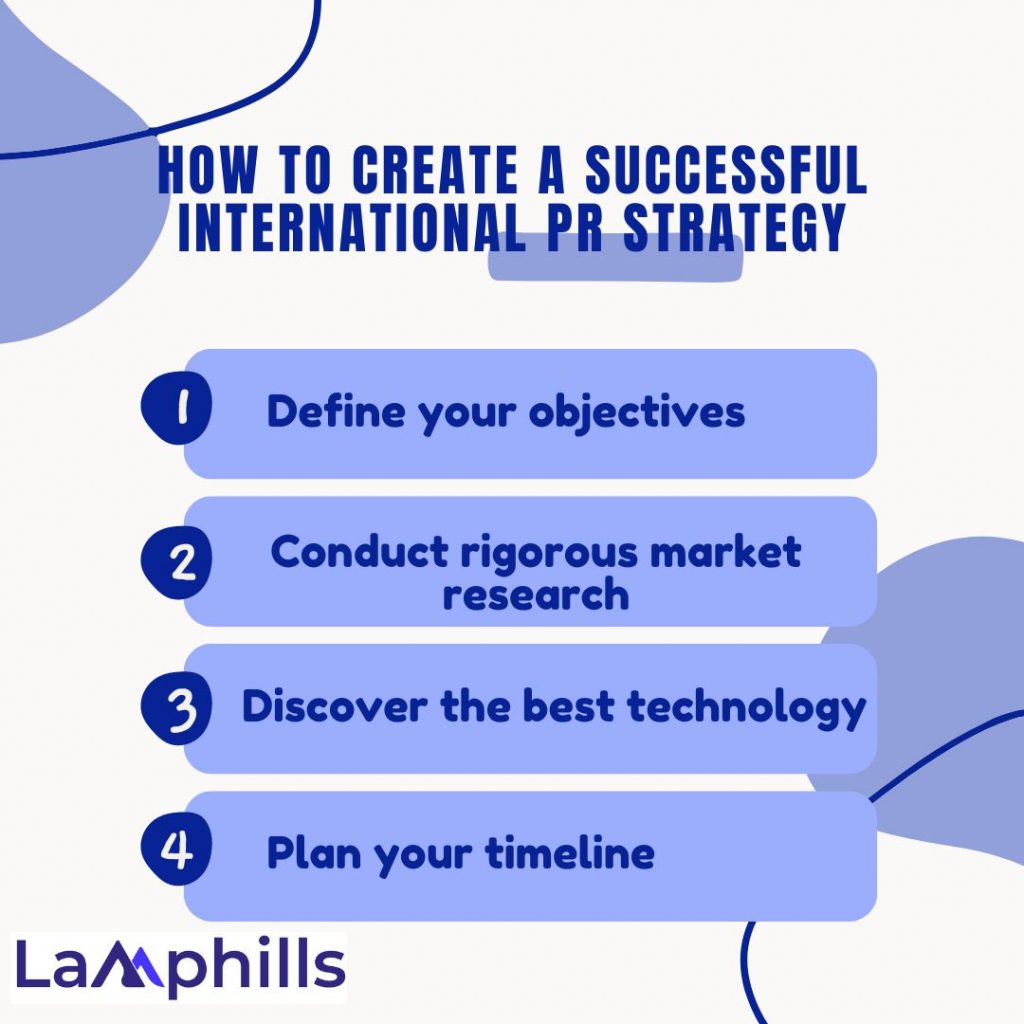Building bridges with international PR is more than just translating press releases; it’s also about knowing cultural nuances, navigating the media landscape, and crafting stories that resonate with people all across the world. As an International PR Specialist, I’ve seen firsthand the potential (and difficulties) of global brand storytelling.
According to a recent Common Sense Advisory survey, more than 70% of consumers prefer to buy from firms that offer material in their local language. This statistic emphasizes the importance of cultural awareness in international PR. Simply translating your message is insufficient; you must adjust it to resonate with the local audience on a deeper level.
But where do you begin? Many materials cover the fundamentals of international public relations, but unlocking the secrets requires understanding the cultural context of your target market. Let’s take a deeper look at the untapped possibilities of international public relations, changing you from a local storyteller to a worldwide brand communication architect.
Public Relations in International Organizations
PR is vital for every organization that wishes to establish and maintain a positive reputation. However, when it comes to international companies, the job of public relations becomes even more important. These companies frequently deal with complicated issues that can be difficult to express to a large audience.
That’s where public relations firms come in. Public relations specialists assist in the creation of clear and succinct communications that are also culturally sensitive and appropriate for the intended audience. Furthermore, public relations may help to create relationships with key stakeholders, which is critical for any firm looking to function successfully on a worldwide scale.
Read Also: Best PR Firms: Discovering the Powerhouses Behind Brand Success.
Early in my work, I managed an international public relations campaign for a language learning program. Our earliest press releases, which were literally translated, took a comic tone that resonated with American consumers. However, in Germany, the joke fell flat, and in China, it was even deemed disrespectful. This cultural faux pas was a stinging reminder of the significance of respecting local sensibilities.
This event prompted me to create the Cultural Context Audit Template. This framework allows us to delve into the cultural intricacies of our client’s target markets.
Here’s the breakdown:
- Market Research: Analyze your target audience’s cultural values, traditions, humor preferences, and media consumption habits.
- Content localization: This entails tailoring your brand messaging, images, and narrative techniques to fit local cultural situations.
- Media Landscape Analysis: Determine the primary media outlets, journalist preferences, and communication methods in your target market.
By using the Cultural Context Audit Template, you can create a tailored international public relations strategy that avoids cultural pitfalls and fosters relationships with your target audience.
Key Takeaways
- International public relations extends beyond translation, requiring an understanding of cultural nuances and adaptation of messages to resonate deeply with various global audiences.
- Effective international PR involves creating communications that are culturally sensitive and clear, assisting organizations in building positive reputations and relationships globally.
- Key challenges in international PR include navigating cultural differences, managing different time zones, and overcoming geographical distances.
- Building a successful international PR strategy requires setting clear objectives, conducting extensive market research, utilizing the right technologies, and constantly adapting to changes in the global media landscape.
Common Challenges in International PR
Working with intellectual property rights may be both thrilling and challenging. Furthermore, you will be able to meet people from all around the world and contribute to the development of partnerships between companies and other countries. In addition, the job alert may present a number of distinct obstacles.
Here are some of the most typical issues encountered by IPR practitioners:
#1. Cultural differences
One of the most difficult aspects of international public relations is navigating cultural differences. There are numerous potential challenges to overcome, ranging from language barriers to differences in customs and traditions. It is critical to be aware to these differences and develop solutions to bridge the cultural gap.
#2. Time zones
Working in IPR also presents the problem of handling multiple time zones. With clients and colleagues spread out over the world, it can be difficult to manage schedules and meet deadlines. Working across time zones requires patience and flexibility.
#3. Distance
Distance is another barrier that IPR practitioners must overcome. The distance can complicate things while traveling for work or coordinating a virtual gathering. Working remotely requires you to be well-organized and efficient.
Working in IPR presents hurdles, but it may also be a rewarding job.
How To Get Started With International PR
To be successful in IPR, you must have a thorough awareness of global affairs and international relations. Here are some tips for getting started using IPR:
#1. Do your research
Make sure to read up on current search terms and refresh your understanding of world history and culture. This will provide you with a good basis for comprehending the complexity of international relations.
#2. Build good communication skills
To be successful in IPR, it is necessary to interact effectively with people from many cultures and backgrounds. To build good communication abilities, consider taking cross-cultural communication programs or studying a foreign language.
#3. Get involved
Participating in organizations dealing with global concerns is one of the finest methods to obtain experience in intellectual property rights. There are other ways to get engaged, including interning at an NGO or working for a think tank that focuses on international affairs.
Alternatively, you can volunteer with relief organizations or work on environmental projects. By participating, you will receive not only useful experience, but also valuable contacts in the field of international public relations.
#4. Be adaptable
Because the realm of intellectual property rights is continually changing, flexibility and adaptability are vital. This entails being eager to learn new things and open to new ideas. It also entails working in a fast-paced setting and being adaptable to change.
#5. Maintain an optimistic mindset
It is also critical to understand that intellectual property law is a difficult field to navigate. There will be occasions when you encounter challenging conditions or people. Maintaining a positive attitude and remembering that your efforts can make a difference in the world is critical. If you’re looking for inspiration, check out some of the most inspirational public relations quotes available.
How To Create a Successful International PR Strategy

When building an effective public relations strategy, firms must think worldwide. Organizations can no longer rely on a one-size-fits-all strategy to communications. With the development of social media and the 24-hour news cycle, companies must be able to adapt their messaging on the fly to cater to diverse audiences in different time zones.
The following are the four tips for creating an effective intellectual property strategy:
#1. Define your objectives
The first step in creating an effective IPR strategy is to establish your goals. What are you hoping to achieve with your communications? Do you want to increase awareness of your company? Increase donations? Change public opinion on a specific subject. Once you’ve identified your goals, you can start developing a strategy to achieve them.
#2. Conduct rigorous market research
To establish an effective IPR strategy, you must first identify your target audience. What European markets are you aiming to reach? So, what are their needs and desires? What motivates them? What are their fears and concerns?
Furthermore, it is necessary to monitor competitors’ communications and analyze their strategy. This can help you understand what has and has not worked in the past. What do other organizations in your field do to reach their target audiences? How can you stand out from the crowd? This understanding is critical for establishing an effective IPR strategy.
#3. Discover the best technology
With the advent of local media, organizations now have access to more communication outlets than before. However, with so many possibilities, choose which ones to employ might be difficult. The best method to locate the correct technology solutions for your firm is to speak with a communications professional who can help you identify the most effective channels for your specific objectives.
Furthermore, you should keep in mind that technology is continually evolving. What works now may not work tomorrow. As a result, remaining current on the newest trends and advances in the field of communications technology is critical.
#4. Plan your timeline
The final step in creating an effective IPR strategy is to set a deadline. When do you wish to attain your goals? What should happen between now and then? This preparation helps keep your communications efforts focused and on track.
Remember that an effective IPR strategy necessitates continual effort. You cannot simply set it and forget it. To be successful, you must be prepared to work day after day, week after week, and month after month.
The recommendations provided above will assist you in developing an effective IPR strategy that will propel your firm forward. But of course, this is only the beginning. The real labor begins when you put your plan into action.
What Is the Role of International Public Relations?
The most recent international public relations job alert is to develop and manage a positive public image for their customer, which can be a corporation, individual, or company. This is accomplished by establishing and sustaining connections with important stakeholders and the media through effective communication techniques.
What are the Benefits of International Public Relations?
Working in international public relations has numerous advantages, one of which is the opportunity to learn about and interact with diverse cultures on a daily basis. However, other benefits include the following:
- You get to travel often (or perhaps live overseas).
- You learn how to effectively communicate across linguistic obstacles.
- You develop a deeper knowledge of global issues.
- You develop strong writing abilities.
- You learn to think quickly and adapt to changing situations.
- You establish a global network of contacts.
- You have the potential to make a significant difference in people’s lives, both in your home nation and overseas.
What is the Difference Between PR and International PR?
Public relations (PR) is the activity of regulating the flow of information between a corporation and the general public. It is often accomplished by developing and spreading information that promotes the organization’s objectives. International public relations, on the other hand, refers to actions that take place across national boundaries. It entails collaborating with many media sources in different nations to develop a coordinated message plan that promotes the organization’s brand and goals internationally.
Conclusion
As our world becomes more interconnected, international public relations plays an increasingly important role in bridging global divides. These bridges are formed not only on compelling stories, but also on cultural awareness, respect, and accurate communication. With the correct approach and the backing of a seasoned organization like Lamphills, every brand may broaden its horizons beyond its local market.
So, while we continue to traverse the complex yet exciting world of international public relations, one question remains: how will you use global storytelling to leave a lasting impression on your brand?
Related Articles
- Unveiling the Power of Publicity: A Comprehensive Guide
- Best Steps To Effective PR Crisis Management
- Media Coverage: Your Blueprint to Captivating Audiences and Making Headlines
- BEST FREE PRESS RELEASE DISTRIBUTION WEBSITES IN 2024
- Best PR Firms: Discovering the Powerhouses Behind Brand Success.






